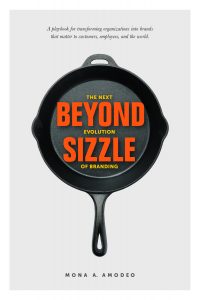Preview Thursday: Beyond Sizzle

Best of Books
October 11, 2018
WI Admin
Topics
Branding, Change, connection, employee retention, Mona Amodeo, Preview Thursday We are pleased to present this excerpt from Chapter 4 of: Beyond Sizzle: The Next Evolution of Branding by Mona Amodeo, Ph. D.
We are pleased to present this excerpt from Chapter 4 of: Beyond Sizzle: The Next Evolution of Branding by Mona Amodeo, Ph. D.
Over the years, branding experts have used their understanding of psychology of social identification to excel at mining the desires of people to be associated with products that confirmed membership in a group that was sexier, richer, or even a little smarter than the next group. While these more superficial human motivations have not disappeared from the scene, today an increasing number of people are making choices that reflect a desire to connect with a set of values, perhaps a little more substantive and impactful.
Jez Frampton, former Global CEO of Interbrand, one of the world’s most respected branding firms, offers this insight into the future of branding:
“If brands start and end with people, it’s important to acknowledge a significant generational shift in the way people interact with, and what they demand from, brands. Both as employees and customers, younger generations have very different views about the brands they choose. They expect a brand’s purpose and values to align with them, and their desires for better communities and a better world.”
Jez Frampton, formal Global CEO of Interbrand
Change creates opportunity. Companies can take advantage of the shifting market forces by becoming thought leaders and champions of the values that are of growing importance to the expanding tribe of cultural creatives. This involves tapping into the wisdom of Edward Bernays’ premise that birthed The Golden Age of Advertising: by creating emotional associations between products and ideas, large numbers of people can be persuaded to change their behavior. By redirecting this underlying (and successful) psychology that was used to sell cigarettes in the 1960s, branding can instead be deployed as a force for good. In doing so branding can be a catalyst for creating positive change by creating stronger connections between people and companies who demonstrate a commitment to values associated with social and environmental responsibility. This opportunity reaches beyond just responding to an existing group of “believers” who represent a significant number of people, to becoming influential voices in shifting the mindsets and behaviors of others who are not yet on board. As far-fetched as this may seem at first glance, it’s actually a logical proposition if we look at the potential of unleashing the psychology of branding to connect people with brands as symbols that represent their highest aspirations—for themselves and the world.
Since the beginning of time (or thereabouts) what has remained a constant driver of the behaviors of the human race is our need for connections that reinforce our sense of self. Over the years, branding has proven a powerful force for creating these connections between companies and what people value. Increasingly, people are scrutinizing the values and behaviors of organizations as key determinants of employment choices and purchasing decisions. They are taking actions that confirm their commitment to values associated with the social and environmental health of their communities and the world.
A recent Nielsen Global Survey of Corporate Social Responsibility provided confirmation that the tribe of cultural creatives is continuing to grow. This worldwide survey of 30,000 consumers in 60 countries was conducted to better understand the impact of the values of corporate responsibility on the attitudes and actions of people. Here’s what was found (Nielsen 2014):
- 67% of consumers prefer to work for socially responsible companies.
- 55% will pay extra for products and services from companies committed to positive social and environmental impact.
- 52% check product packaging to ensure sustainable impact.
- 52% made at least one purchase in the past six months from one or more socially responsible companies.
- 49% volunteer and/or donate to organizations engaged in social and environmental programs.
Strategies that connect with this tribe create wins in a couple of areas: first, people are looking to buy innovative products and services that embody these values. Meeting this demand supports the financial bottom line. A second win is created when organizations become places where members of this tribe can live out what they believe through their work. This results in organizations attracting (and retaining) their most valuable resource—committed, talented, and engaged employees.

Mona Amodeo, Ph.D. is an innovator and catalyst for transforming organizations into brands that matter. She is an award-winning management strategist and recognized expert in organization development and change on a mission to move business-as-is to business-as-it-can be. Her work spans the boundaries of scholarship and practice in the disciplines of branding, communications, and organization culture. Find her on:
Twitter, Facebook and LinkedIn.






